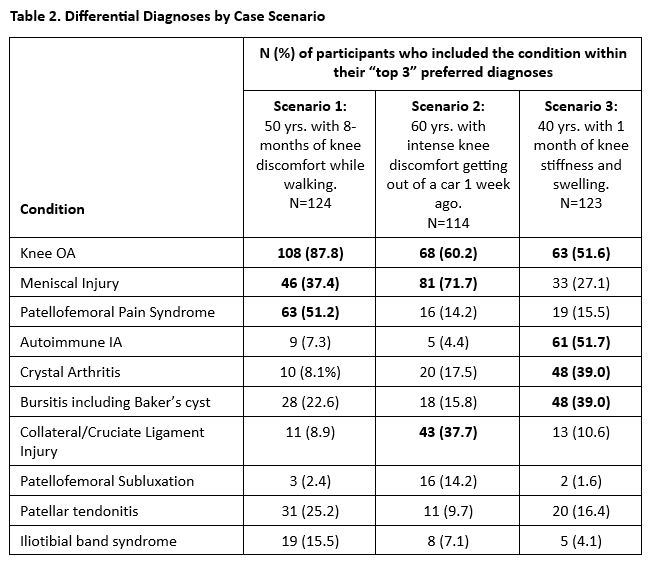Session Information
Session Type: Poster Session B
Session Time: 10:30AM-12:30PM
Background/Purpose: Osteoarthritis Research Society International (OARSI) has launched an initiative to develop classification criteria for early-stage symptomatic knee osteoarthritis (EsSKOA). In individuals with undiagnosed knee symptoms, the criteria aim to identify those with knee OA without established radiographic OA for entry into OA prevention trials. An international Delphi survey generated candidate items to be considered in the criteria. The next step is to assess the capacity of these items to increase or decrease the likelihood of EsSKOA versus other conditions (mimics). The current study sought to elicit diverse clinicians’ differential diagnosis for people presenting with undiagnosed knee symptoms.
Methods: An online survey was sent to clinicians who consult on individuals with knee symptoms (e.g., physiotherapy, sports medicine, physiatry, and others). Participants were recruited from Delphi survey respondents, purposive sampling of initiative member’s networks, and snowball sampling (participants invited other individuals to participate). Those who see, on average, at least five patients per month with undiagnosed knee symptoms were eligible. Three cases scenarios were presented: 50 yrs. with 8-months of knee discomfort while walking; 60 yrs. with intense knee discomfort getting out of a car 1 week ago; and 40 yrs. with 1 month of knee stiffness and swelling. For each, participants were asked if they see such people in their practice (yes/no). If yes, they were asked to indicate the top three differential diagnoses from a predefined list of conditions, and any other conditions we may have missed (open text box). Demographic and practice characteristics were collected to describe participants.
Results: 127 clinicians responded (43% female, 48% in practice ≤ 15 years, 50% academics). Table 1 Participants represented 8 clinical disciplines (32% sports medicine; 21% rheumatology; 14% general practice; 13% physiotherapy; 13% orthopaedics; and 6% physiatry) and 6 continents (59% North America; 24% Europe, 8% Asia, 6% Australia, 2% Africa; and 1% South America). Knee OA, including patellofemoral OA, was among the top three conditions in the differential diagnosis for all three scenarios, followed by patellofemoral pain syndrome (scenario 1), meniscal injuries (scenarios 1 and 2), collateral and cruciate ligament injuries (scenario 2), and conditions associated with knee swelling, e.g., bursitis and inflammatory arthritis (scenario 3) Table 2. Other conditions were identified (referred pain from the hip or lumbar spine, avascular necrosis of the knee, fracture, plica syndrome, and hemarthrosis), but none was considered among the top three conditions for any scenario.
Conclusion: From our survey of a large, diverse group of musculoskeletal clinicians, the differential diagnosis of people presenting with undiagnosed knee symptoms should include knee OA, meniscal, ligament and tendon injuries, bursitis, and inflammatory arthritis. Data collected on patients with these conditions will be required to assess the ability of our candidate items, alone and in combination, to discriminate individuals with EsSKOA from individuals with other common conditions.
To cite this abstract in AMA style:
Hawker G, King L, Liew J, Wang Q, Mahmoudian A, Jansen N, Stanaitis I, Runhaar J, Appleton T, Turkiewicz A, Englund M, Lohmander S, Haugen I, Neogi T. OARSI Initiative to Develop Classification Criteria for Early-Stage Symptomatic Knee OA (EsSKOA): What Should Be Considered in the Differential Diagnosis of EsSKOA? [abstract]. Arthritis Rheumatol. 2024; 76 (suppl 9). https://acrabstracts.org/abstract/oarsi-initiative-to-develop-classification-criteria-for-early-stage-symptomatic-knee-oa-esskoa-what-should-be-considered-in-the-differential-diagnosis-of-esskoa/. Accessed .« Back to ACR Convergence 2024
ACR Meeting Abstracts - https://acrabstracts.org/abstract/oarsi-initiative-to-develop-classification-criteria-for-early-stage-symptomatic-knee-oa-esskoa-what-should-be-considered-in-the-differential-diagnosis-of-esskoa/


